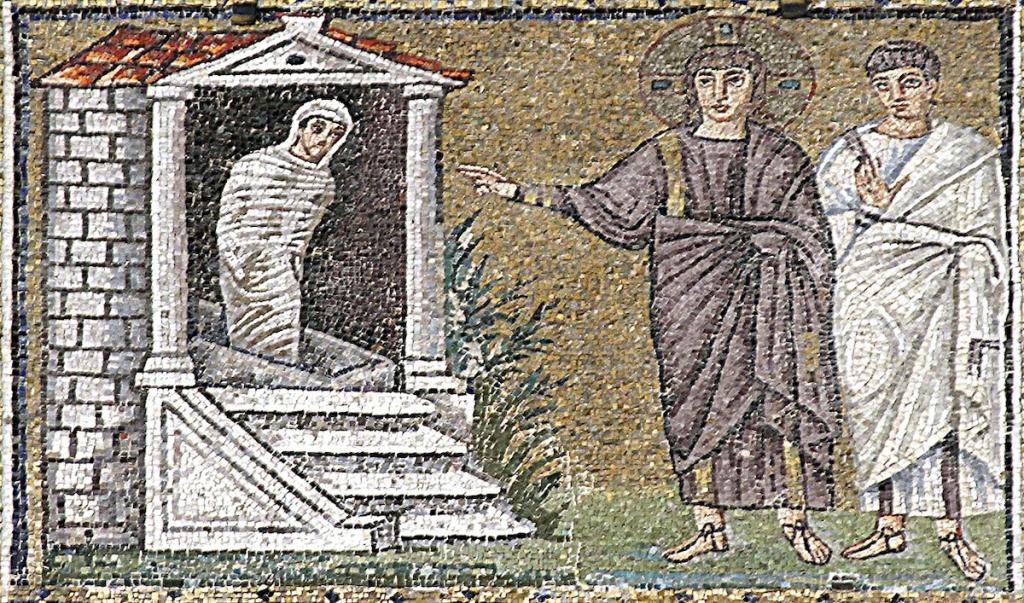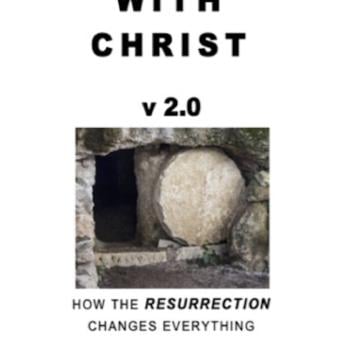
Jesus’ death was not the end of his story, and so we have in the Gospels the culmination of all previous resurrection hopes. But the Gospels themselves talk about resurrection even before Jesus’ death. In this chapter let’s examine those references to resurrection.
We continue our journey through the Bible’s teaching on resurrection by looking at the four gospels in this the latest revised chapter from my book Raised With Christ: How the Resurrection Changes Everything.
I am the resurrection and the life. Whoever believes in me,
though he die, yet shall he live, and everyone who lives
and believes in me shall never die.JOHN 11:25–26
Some insects are born and die within the space of a few hours. Most of us hope we will live into our eighties or beyond, but even then we feel robbed if told we are terminally ill. When a baby lives just a few short minutes after birth, we feel outraged. We have a hunger to live forever because we were designed to live forever.
We now turn to the accounts of a person whose life was cut short in his prime. By the age of approximately thirty-three Jesus had not married, had not been a parent, and had not received a retirement lump sum or gone on a long-awaited cruise. His life had achieved only a three-year period of notoriety that would have faded quickly if his crucifixion had been the end.
But Jesus’ death was not the end of the story, and so we have in the Gospels the culmination of all previous resurrection hopes. But the Gospels themselves talk about resurrection even before Jesus’ death. In this chapter let’s examine those references to resurrection.
THE FIRST-CENTURY JEW’S VIEW OF RESURRECTION
By the time of Jesus, Jews had a variety of opinions about resurrection. The Old Testament does teach a resurrection of the dead. However, it is easy to see why some of these passages might have seemed less than clear to many of their original readers. Indeed, even today many Jews do not believe in a physical resurrection.
One historical example of belief in resurrection was the Jewish rebel who rather than be captured cut himself open with a sword and pulled out his bowels, throwing them at the crowd and proclaiming his belief that God would give them back to him in the future age to come.[1]
The Pharisees held a firm belief in the physical resurrection of the dead, based on their interpretation of the Old Testament Scriptures. The Sadducees, on the other hand, believed death was the end. As many of us remember learning in Sunday school, this belief caused them to be “Sad, you see.” Paul took advantage of this fact in his speech in Acts 23, leading to an argument between the Pharisees and the Sadducees.
Some Jews believed the Messiah would be able to raise the dead. When John the Baptist’s followers asked Jesus if he was the Messiah, Jesus listed this evidence: “The blind receive their sight and the lame walk, lepers are cleansed and the deaf hear, and the dead are raised up, and the poor have good news preached to them” (Matthew 11:5).
King Herod showed he was aware of the possibility of resurrection when he said of Jesus, “This is John the Baptist. He has been raised from the dead; that is why these miraculous powers are at work in him” (Matthew 14:2).
MIRACULOUS RESURRECTIONS PERFORMED BY JESUS
That Jesus had raised the dead was every bit as dramatic in the first century as it would be today. It would be naive to think that the Jews of Jesus’ day were any less ignorant of the “fact” that once someone has died, they simply do not rise from the dead in everyday experience. The Jews were as skeptical as we would be today if we heard such stories.
Thus, the miraculous resurrections Jesus performed were incredibly significant. Only three clear resurrections (those associated with Elijah and Elisha) had been recorded in Scripture until this point. It would have been astonishing for anyone in those days to hear of a man who raised the dead.
If you invited Jesus to a funeral, there was a real chance that he might disrupt the proceedings by raising the body from the dead (see Luke 7:11–17). Three of the Gospels record the story of Jairus’ daughter being raised from the dead (Matthew 9:18–26; Mark 5:22–43; Luke 8:41–56). Jesus’ claim that she was only asleep prompted the same mockery that it would today. He viewed death very differently than the mourners. Death is merely a rest from which we will all one day be awakened, whatever our destiny thereafter.
One of the most emotive events in the whole Bible takes place when a friend of Jesus dies. The pain of Lazarus’ sister is tangible. In a sense everything the Bible has shown us about the problem of death climaxes at this moment. Suddenly we see the compassion of Jesus in the strength of his emotional response to the devastating impact of death. Jesus’ heart is moved, and he shares the pain we all feel at losing people to this unwelcome intruder into God’s perfect universe.
Jesus is about to demonstrate for all to see his mastery over death in raising his friend from the dead. But, first, he weeps. Jesus is the God who knows every pain, who understands, who weeps. He is the God who has come to us, the comforter. Simon Brading and Graham Kendrick have written a song on the Lazarus account that beautifully portrays this perspective (“God of Compassion,” available on all streaming platforms.
Before Lazarus was resurrected, a revealing conversation took place between Jesus and Martha.
Jesus said to her, “Your brother will rise again.” Martha said to him, “I know that he will rise again in the resurrection on the last day.” Jesus said to her, “I am the resurrection and the life. Whoever believes in me, though he die, yet shall he live, and everyone who lives and believes in me shall never die.” (John 11:21–27)
There is scarcely a more dramatic statement in the whole of Scripture.
JESUS’ TEACHING ABOUT RESURRECTION
N.T. Wright argues that, surprisingly, in Jesus’ teaching, “resurrection was obviously not one of his central or major themes.”[2] Jesus does, however, speak about resurrection, and because of the universal fear of death, it seems clear that great importance would have been given to his teaching on that subject.
Jesus spoke about “the age to come”[3] and promised that the kingdom of God was coming.[4] Much of his teaching required a time of future blessing as a reward for present obedience. A good example of this is found in Luke 12, when, as N. T. Wright indicates, “The only point in telling people not to be afraid of those who can kill the body is if there is a life to look forward to beyond bodily death.”[5] This future reward is elsewhere described as “entering life.”[6] Jesus also promised that if we obey him, we “will be repaid at the resurrection of the just” (Luke 14:14).
Jesus taught that our earthly bodies will rise to face an eternal future of life or judgment: “An hour is coming when all who are in the tombs will hear his voice and come out, those who have done good to the resurrection of life, and those who have done evil to the resurrection of judgment” (John 5:28–29). Elsewhere he says, “No one can come to me unless the Father who sent me draws him. And I will raise him up on the last day” (John 6:44).
Jesus assures us, “Because I live, you also will live” (John 14:19) and promises, “My sheep hear my voice, and I know them, and they follow me. I give them eternal life, and they will never perish, and no one will snatch them out of my hand. My Father, who has given them to me, is greater than all, and no one is able to snatch them out of the Father’s hand” (John 10:27–29).
Jesus announces that he himself is the answer to all the concerns people have about the brevity and frailty of life, effectively saying, “Come to me, and I will give you a life that lasts forever—life in all its fullness” (see John 10:10).
Jesus’ words suggest that we require a new life right now. This echoes the words found in John 1 and 3 which speak of our need to be born again. The implication is that without Christ, people are already in one sense dead.
Jesus also hints at this idea in the parable of the prodigal. When the son returns, the father reprimands the ungracious older brother: “It was fitting to celebrate and be glad, for this your brother was dead, and is alive; he was lost, and is found” (Luke 15:32). While these words are almost certainly meant metaphorically in that the deadness of the prodigal reflects his separation from the father, our spiritual deadness is caused precisely by such a separation from our heavenly Father through sin. A reunion with our own Father will result in a spiritual resurrection inside us. As Jesus prayed shortly before his death, “And this is eternal life, that they know you the only true God, and Jesus Christ whom you have sent” (John 17:3).
A number of Jesus’ parables talk about the coming kingdom of God, resurrection, and/or the afterlife. The most well-known is the story of the rich man and Lazarus found in Luke 16:19–31. We are told there of a divide between the righteous and the unrighteous in the afterlife. The message is that even if someone were to be resurrected and returned to the earth, people would not believe his warnings. This is poignant as when the namesake of this parable, Lazarus, was raised from the dead, the Jewish rulers promptly wanting to murder him, rather than turn to Jesus (John 12:10).
JESUS PREDICTS HIS OWN RESURRECTION
Jesus repeatedly told his disciples that “he must go to Jerusalem and suffer many things from the elders and chief priests and scribes, and be killed, and on the third day be raised” (Matthew 16:21).[7]
Jesus warned that following him requires short-term sacrifice, possibly even death, for long-term gain: “The hour has come for the Son of Man to be glorified. Truly, truly, I say to you, unless a grain of wheat falls into the earth and dies, it remains alone; but if it dies, it bears much fruit. Whoever loves his life loses it, and whoever hates his life in this world will keep it for eternal life” (John 12:23–25).
By allowing his three closest disciples to see him in his transfigured and glorified state, Jesus demonstrated the importance of resurrection. If they had any doubts about his deity, this experience might be expected to remove them. However, it seems that they simply did not understand what was happening. On the mountain he was transfigured into a similar state to his risen and ascended glorification. Also, the presence of Elijah and Moses underlined the reality of eternal life for the believer. In case they hadn’t understood from their reading of the Old Testament, they saw that not only had Elijah escaped death (2 Kings 2:11), but Moses was also now alive and well. In case the disciples had missed the faith-stimulating implications of this moment and its demonstration of resurrection power, Jesus ordered them, “Tell no one the vision, until the Son of Man is raised from the dead” (Matthew 17:9).
Jesus did not want reports of his transfiguration to be immediately proclaimed to others. This was a revelation of God’s power, but it was not yet the time for it to be made known. Jesus’ resurrection would be the ultimate sign to everyone that he was the Son of God. It would be the act that would make forgiveness and eternal life for all believers possible.
The disciples were somewhat bemused by Jesus’ words about him rising from the dead. What seems like very clear words to us were not understood by them. On the return from the mountain they were “questioning what this rising from the dead might mean” (Mark 9:10). We can only speculate whether they were kept from understanding by their own beliefs about how the Messiah would come as a conquering military figure or whether they were suffering spiritual blindness, which can make otherwise intelligent people not understand the simple truth of the gospel.[8]
Jesus also promised that he would send his Spirit to them and that this would not be possible unless he went away. He even said that this would be better for them and that the Spirit would lead them into all truth. This enabled some of them to write the New Testament for us so we would have an objective source of truth to live by (see John 14–16).
On the night that he would be betrayed, Jesus promised that he would rise again and that his followers would also share in his future glory. Jesus looked through the agony of the cross and saw it as enabling his glorification, which obviously presupposed his resurrection:
Father, the hour has come; glorify your Son that the Son may glorify you, since you have given him authority over all flesh, to give eternal life to all whom you have given him. And this is eternal life, that they know you the only true God, and Jesus Christ whom you have sent. I glorified you on earth, having accomplished the work that you gave me to do. And now, Father, glorify me in your own presence with the glory that I had with you before the world existed. . . .
Father, I desire that they also, whom you have given me, may be with me where I am, to see my glory that you have given me because you loved me before the foundation of the world. (John 17:1–5, 24)
These wonderful words promise us an eternal future of joy with our Savior united with God. However, for this to be accomplished Jesus knew he must first experience the agony of the cross. His words later that night in the Garden of Gethsemane should be seen in the context of his faith in a glorious future resurrection. He is, however, painfully aware of the cup of God’s wrath that must first be drained by him for his people to enjoy this wonderful future. It really was for the joy that was set before him that he endured the cross (see Hebrews 12:2). It was essential that the punishment was to be borne in this way so that we could experience new life. The words of Jesus’ prayer are all the more poignant if we understand just what was at stake and what he was suffering for:
My Father, if it be possible, let this cup pass from me; nevertheless, not as I will, but as you will. . . . My Father, if this cannot pass unless I drink it, your will be done. (Matthew 26:39–42)
The resurrection of Jesus is the key event in human history that makes sense of all the Old Testament references to resurrection, and the rest of the New Testament’s teaching flows from this event.
REFERENCES ARE FOUND AT THE BOTTOM OF THIS PAGE
Raised With Christ would never have been possible without heavy use of Logos Bible Software. If you do not yet have this wonderful Bible Study tool or you are due an upgrade, readers of this blog get a 10% discount.
READ MORE
Chapter One:
Chapter Two:
Chapter Three:
Chapter Four:
Chapter Five:
Chapter Six
REFERENCES
[1]See 2 Maccabees 14:46 in the Apocrypha.
[2]N. T. Wright, The Resurrection of the Son of God (London: SPCK, 2003), 403.
[3]Matthew 12:32; Mark 10:30; Luke 18:30.
[4]Luke 17:20; 22:18.
[5]Wright, The Resurrection of the Son of God, 431.
[6]Mark 9:43–48.
[7]7See also Matthew 17:23; 20:19; Mark 8:31; 9:31; 14:28.
[8]8See 2 Corinthians 4:3–5.














